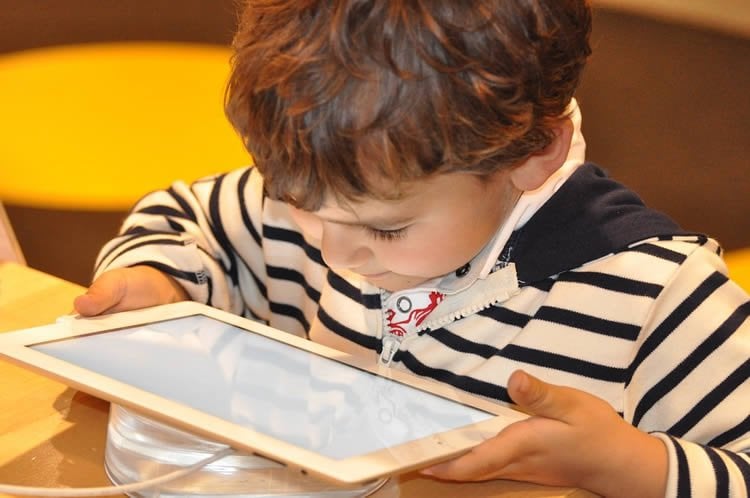Summary: A new study provides insight into educational apps and those designed for small children may be tailored to fit child specific learning needs.
Source: Frontiers.
When it comes to educational apps for kids, interactivity can either help or hinder learning and researchers are beginning to understand which strategies really benefit children.
Educational apps for kids can be valuable learning tools, but there’s still a lot left to understand about how to best design them, shows a report in Frontiers in Psychology.
“Our experiments are a reminder that just because touchscreens allow for physical interaction, it doesn’t mean that it’s always beneficial,” says Dr. Colleen Russo-Johnson, lead author of the study and who completed this work as a graduate student at Vanderbilt University.
Smartphones and tablets have become so pervasive that, even in lower-income households, 90% of American children have used a touchscreen by the age of 2. Eighty percent of educational apps in the iTunes store are designed for children–especially toddlers and preschoolers. But recent research has shown that sometimes all those chimes and animations hinder learning, prompting the question, how well do we understand what it takes to make a truly beneficial learning app?
“Children interact with touch screens and the embedded media content in vastly different ways and this impacts their ability to learn from the content,” says Russo-Johnson. “Our experiment focused on how children interacted with touchscreen devices–on a more basic level–by stripping away fancy design features that vary from app to app and that are not always beneficial.”
Using a custom-made, streamlined learning app, Russo-Johnson and her colleagues showed that children as young as 2 could use the app to learn new words such as the fictional names of a variety of newly-introduced toys (designed specifically for the study). Unsurprisingly, slightly older children (age 4 to 5) were able to learn more than the younger ones (age 2 to 3) and they were also able to follow directions better–such as only tapping when instructed to do so.
The researchers went on to show that the excessive tapping by younger children seemed to go hand-in-hand with lower scores of a trait called self-regulation. As in this study, self-regulation is commonly measured by seeing how long children can keep themselves from eating a cracker that is placed in front of them–after they’ve been told to wait until they hear a signal that it’s ok to eat the cracker.
To complement this first study (which included 77 children), Russo-Johnson and her colleagues designed a second app to see which interactions–tapping, dragging, or simply watching–were better for learning new words.
Somewhat surprisingly, across this next group of 170 2- to 4-year olds, no single type of interaction proved to consistently be the best. But there were differences depending on age, gender, and the extent of prior exposure to touchscreens at home. Boys appeared to benefit more from watching, whereas dragging seemed best for girls and children with the most touchscreen experience.

These results complement the growing body of research on identifying effective interactive features, as well as providing insight into how apps might be tailored to fit the learning needs of different children.
“I hope that this research will inform academics and app developers alike,” says Russo-Johnson. “Educational app developers should be mindful of utilizing interactivity in meaningful ways that don’t distract from the intended educational benefits, and, when possible, allow for customization so parents and educators can determine the best settings for their children.”
Funding: The research was supported by National Science Foundation Graduate Research Fellowship to Colleen Russo (DGE: 14445197) by Peabody College, Vanderbilt University.
Source: Melissa Cochrane – Frontiers
Image Source: NeuroscienceNews.com image is in the public domain.
Original Research: Full open access research for “All Tapped Out: Touchscreen Interactivity and Young Children’s Word Learning” by Colleen Russo-Johnson, Georgene Troseth, Charlotte Duncan and Almaz Mesghina in Frontiers in Psychology. Published online April 12 2017 doi:10.3389/fpsyg.2017.00578
[cbtabs][cbtab title=”MLA”]Frontiers “How Do Toddlers Learn Best From Touchscreens?.” NeuroscienceNews. NeuroscienceNews, 8 May 2017.
<https://neurosciencenews.com/toddler-touchscreen-learning-6617/>.[/cbtab][cbtab title=”APA”]Frontiers (2017, May 8). How Do Toddlers Learn Best From Touchscreens?. NeuroscienceNew. Retrieved May 8, 2017 from https://neurosciencenews.com/toddler-touchscreen-learning-6617/[/cbtab][cbtab title=”Chicago”]Frontiers “How Do Toddlers Learn Best From Touchscreens?.” https://neurosciencenews.com/toddler-touchscreen-learning-6617/ (accessed May 8, 2017).[/cbtab][/cbtabs]
Abstract
All Tapped Out: Touchscreen Interactivity and Young Children’s Word Learning
Touchscreen devices differ from passive screen media in promoting physical interaction with events on the screen. Two studies examined how young children’s screen-directed actions related to self-regulation (Study 1) and word learning (Study 2). In Study 1, 30 2-year-old children’s tapping behaviors during game play were related to their self-regulation, measured using Carlson’s snack task: girls and children with high self-regulation tapped significantly less during instruction portions of an app (including object labeling events) than did boys and children with low self-regulation. Older preschoolers (N = 47, aged 4–6 years) tapped significantly less during instruction than 2-year-olds did. Study 2 explored whether the particular way in which 170 children (2–4 years of age) interacted with a touchscreen app affected their learning of novel object labels. Conditions in which children tapped or dragged a named object to move it across the screen required different amounts of effort and focus, compared to a non-interactive (watching) condition. Age by sex interactions revealed a particular benefit of dragging (a motorically challenging behavior) for preschool girls’ learning compared to that of boys, especially for girls older than age 2. Boys benefited more from watching than dragging. Children from low socioeconomic status families learned more object names when dragging objects versus tapping them, possibly because tapping is a prepotent response that does not require thoughtful attention. Parents and industry experts should consider age, sex, self-regulation, and the physical requirements of children’s engagement with touchscreens when designing and using educational content.
“All Tapped Out: Touchscreen Interactivity and Young Children’s Word Learning” by Colleen Russo-Johnson, Georgene Troseth, Charlotte Duncan and Almaz Mesghina in Frontiers in Psychology. Published online April 12 2017 doi:10.3389/fpsyg.2017.00578






